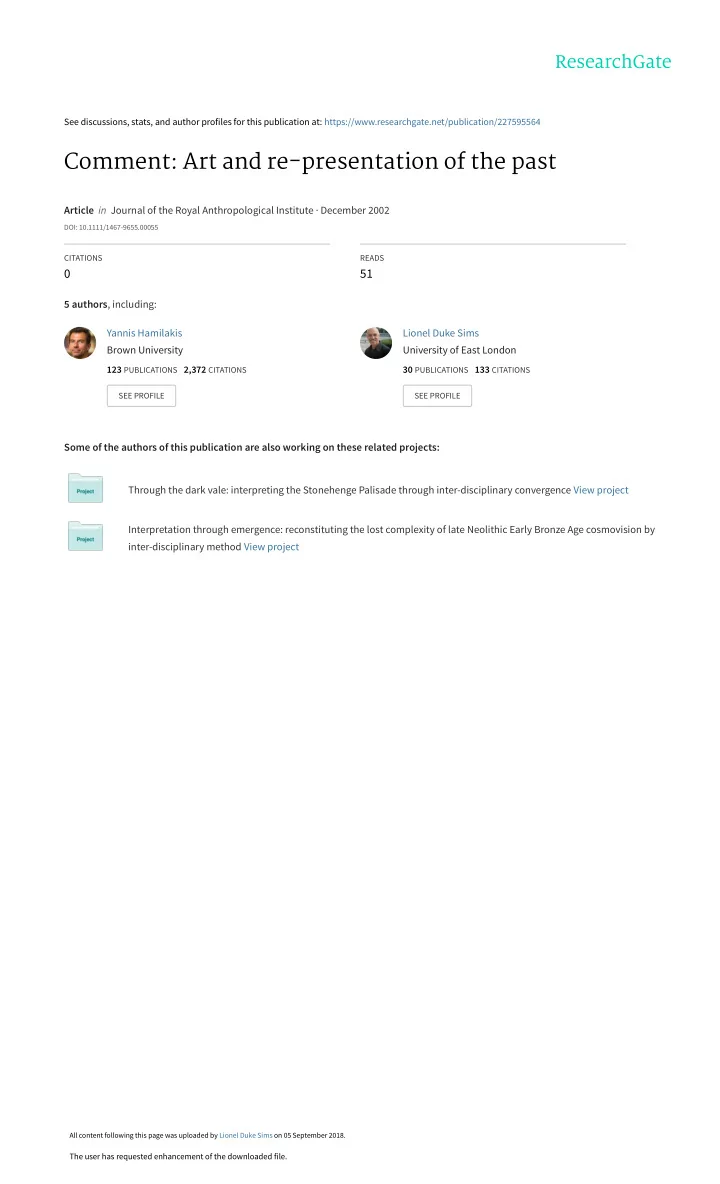

See discussions, stats, and author profiles for this publication at: https://www.researchgate.net/publication/227595564 Comment: Art and re‐presentation of the past Article in Journal of the Royal Anthropological Institute · December 2002 DOI: 10.1111/1467-9655.00055 CITATIONS READS 0 51 5 authors , including: Yannis Hamilakis Lionel Duke Sims Brown University University of East London 123 PUBLICATIONS 2,372 CITATIONS 30 PUBLICATIONS 133 CITATIONS SEE PROFILE SEE PROFILE Some of the authors of this publication are also working on these related projects: Through the dark vale: interpreting the Stonehenge Palisade through inter-disciplinary convergence View project Interpretation through emergence: reconstituting the lost complexity of late Neolithic Early Bronze Age cosmovision by inter-disciplinary method View project All content following this page was uploaded by Lionel Duke Sims on 05 September 2018. The user has requested enhancement of the downloaded file.
COMMENT Art and the re-presentation based on the assumption that sight would have been the most crucial sensory engagement of of the past the prehistoric people with these features. In fact, this line of argument is a by-product of recent phenomenological trends in archaeol- Tilley, Hamilton, and Bender (2000) discuss a ogy which, despite the oft-repeated appeals to number of important issues to do with art and bodily experience and embodiment, mostly the representation of the past and, although I focus on sight and vision (e.g. Tilley 1994). feel that they do not do justice to the com- Evidently this approach is a reflection of the plexities of the issue (for example, they fail to Western bias towards vision from the eigh- mention and engage with the tradition of teenth century onwards (Classen 1997 a : 402). archaeology as art history, so prominent in In the Western hierarchy of the senses, vision many contexts outside the Anglo-Saxon occupied the highest position, forming with canon), their arguments are worth taking seri- hearing the ‘high’ or ‘distant’ senses; touch, ously and constitute another welcome and smell, and taste, on the other hand, were important addition to the growing literature classed as the ‘low’ or ‘close’ senses (cf. Hami- on multivocality in archaeological fieldwork. lakis in press; Rodaway 1994: 26), a sensory Here I take issue with only one crucial hierarchy with strong gender connotations aspect of their argument, typical of the (Classen 1997 b ; but see Nash 1996). These broader trends in recent influential theoretical ideas were closely associated with notions that currents in archaeology, as well in other dis- attribute a privileged role to the gaze and ciplines. The art installations created by the construct science as a mode of observation; authors (2000: 47-9) at Leskernick aimed, they were also linked with emerging media amongst other things, at ‘acknowledging and such as photography, as well as with a notion making tangible … the possible significance of of embodiment which emphasized bodily these stones to its prehistoric inhabitants’. It is control and middle-class respectability. this particular point that I want to interrogate Y et a growing body of work in anthropol- here, the idea that installations like the ones ogy, as well as in fields like history and human employed by the authors will be able to con- geography, has shown time and again that tribute to the understanding of the meaning many pre-modern and non-Western modes of and significance that prehistoric people at- bodily engagement with the world deploy a tributed to landscape features. My objection variety of sensory devices, and not simply or is this: while the authors wish to understand primarily vision. Even as late as the sixteenth prehistoric people’s engagement with their century in France, for example (Febvre 1982: environment and its surrounding features, 423-37), sight seems to have been less devel- most if not all of the installation devices they oped and of less importance than touch, smell, adopted seem to privilege only one specific or hearing. Things that people in the West mode of engagement, visual perception.These now would describe in visual terms, would include the attempt to highlight the shape of have been then described in haptic, olfactory, rocks by wrapping them with cling-film and and auditory terms. painting them, producing visual frames based T o return to Tilley, Hamilton, and Bender’s on the shape of doors and horizon silhouettes paper, while the shape of the rocks in Lesker- through the doorways, highlighting prominent nick may (or may not) have been a prominent features with flags, documenting the installa- feature in prehistoric people’s bodily encoun- tions with photographs, and so forth. ters with them, why should we not assume While these devices are interesting ways of that the texture of the rock (sensed through conceptualizing perceptions of space, they are touch) and even the sound of the rock when
Recommend
More recommend